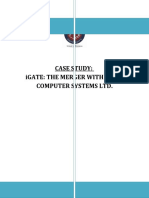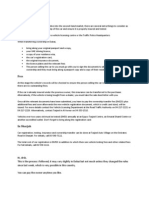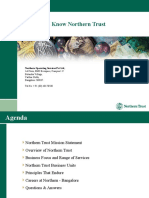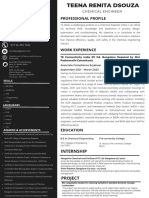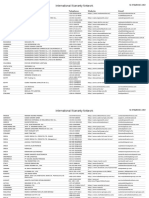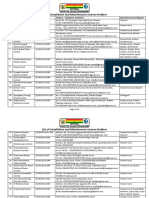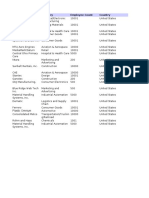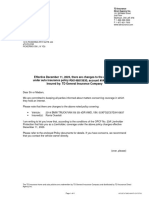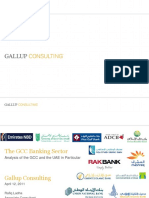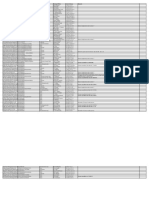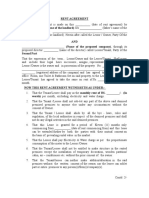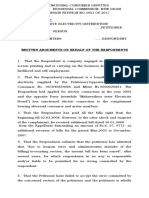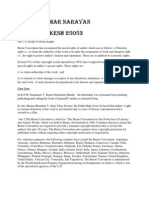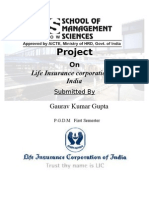General Insurance Business Underwriting
General Insurance Business Underwriting
Uploaded by
Mukesh LalCopyright:
Available Formats
General Insurance Business Underwriting
General Insurance Business Underwriting
Uploaded by
Mukesh LalOriginal Description:
Original Title
Copyright
Available Formats
Share this document
Did you find this document useful?
Is this content inappropriate?
Copyright:
Available Formats
General Insurance Business Underwriting
General Insurance Business Underwriting
Uploaded by
Mukesh LalCopyright:
Available Formats
GENERAL INSURANCE BUSINESS UNDERWRITING
R.Qaiser, Professor, NIA, Pune
For a general insurance company, underwriting business is the basic core activity. All other activities, in fact, emanate from this core activity only. Not much attention was being paid to this core activity in the nationalized set-up under tariff era. Underwriting was reduced to referring to the pages of tariff. There was no application of mind. Any innovation was out of question. The customer has to tailor his needs according to the available products rather than it being other way. In an environment like this the underwriting skill and expertise development saw a decline. Then came the liberalization of insurance sector and gradual withdrawal of tariff with the ultimate aim of ushering in a fully tariff free regime. Suddenly underwriting became all important. The environment became very competitive. Profit and solvency concern forced insurance companies to relook at there underwriting operation. Then came IRDA regulation on File & Use system. This meant amongst other, all insurance company must have
An underwriting policy duly approved by the board The pricing has to be actuarially evaluated and if it is subsidized, this has to be spelt out.
The concept of appointed actuary in general insurance company has come. Nominated underwriters & issues connected with that. Marketing & underwriting delinked.
Then there are regulations to protect policyholders interests and certification of outstanding claims provisioning by Appointed Actuary. These regulations have their own bearing on underwriting and pricing, which cannot be ignored now. There is now talk of risk perception based effective underwriting. Risk management and related issues are increasingly becoming crucial and important which is the way it should always be. Persuit of premium for obvious reasons is the goal of all general insurance companies. But this premium underwritten must be quality premium and must
generate profit. The excellence and the quality of underwriting will determine the long term survival of general insurance companies. This realization is now coming. Then there are whole lot of other issues (e.g. marketing, claims settlement, investment operation, etc.) which are dependent upon the underwriting operation of the company. The underwriting issues therefore can not be seen in isolation and there is a need to relook at things in the present day context.
Lets now examine what does underwriting entail, how is the underwriting philosophy /policy of a company is formulated and how this policy is monitored for effective implementation. But before that let us discuss the corporate goal of a general insurance company because policies in other areas of operation must fit in and help achieve the corporate goal.
In todays world most of the organizations have vision and mission statements. Insurance companies are no exception. These statements provide the broad frame work within which the corporate goals / objectives of the insurance companies are set. The corporate objectives provide the business direction for medium and long term goals. This involves understanding as to where the organization stands now, its core capabilities, strength and weakness and the environment (business, social and economic, regulatory / legal etc,) in which it operates. Bases on these understandings, the road map to achieve the goal is set. Corporate objectives covers whole range of the organizations activities including the underwriting goal. The underwriting policy of the company must therefore be capable of delivering the required results and accordingly must be subject to continues review for its effectiveness.
Underwriting basically refers to the process of evaluating a proposal that comes for insurance. Based on the evaluation done a decision is to be taken as to the acceptance of proposal or otherwise. If its is to be accepted, at what price and on what terms, conditions and coverages. This process ends with the issue of policy documents. For a routine kind of simple proposal, the entire procedure is very simple. Generally insurance companies have internal guide rates and standard policy documents, for
these routine risks which a re typically High frequency, low severity risk and do not require much of an underwriting expertise & skill. But the aggregate of simple risk across the company, and the likely financial consequences needs monitoring. However, typically for low frequency high severity risk e.g. liability, aviation, etc. or unusual risk, or risk with every high sum insured, etc. the underwriting process becomes more complex and whole lot of other issues having bearing on acceptance of such risk come in the picture. These include :-
Underwriting capacity and retention on own account and solvency concern Reinsurance arrangement and cost associated with that Availability of technical expertise for underwriting big and complex risk in the company.
The authority to accept such risks and the underwriting policy of the company.
For simple risk, the evaluation is done through the information contained in the proposal form. For big and complex, industrial risk, the evaluation is done through risk inspection carried out by specialist trained engineers of the insurance company. Individual risk peculiarities will vary and the report of the risk engineer comprehensively examine the physical hazard aspects in relation to the perils covered. Depending upon the class of business, additional questions may be asked through a questionnaire. For medical insurance, medical check up and diagnostic test may be insisted upon. Moral hazard aspects are difficult to assess. But for big corporate clients, it is worthwhile to examine their corporate governance, risk
management philosophy, safety and investigation mechanism and above all the quality, skill and experience of manpower in handling and minimizing loss. All said, insurance companies are always exposed to adverse selection. Whether it is proposal form, questionnaire or risk inspective, the idea is to get all relevant information for an informed underwriting. Insurance companies have to be on their guard for adverse selection and moral hazard aspect.
After having decided to accept the proposal after due evaluation, the next step is to decide about the pricing and this involves matching of risk to price (via experience and modeling) as also limiting of potential loss exposure through some mechanism. Insurance is an intangible product and pricing intangible product is difficult for it cannot be based on deterministic model traditionally used for tangible goods / products. The uncertainty about frequency and severity of claims makes the pricing task of insurance product very difficult. We have to make use of stochastic models which are based on theory of probability. Based on the past data (experience), these model help us in making prediction about the likely number of claims that are expected to be reported as also about the average claims size. The expected claims cost is worked out by multiplying the two. The claims cost must also take into account the provision for IBNR & IBNER claims. Inflation must also be factored in pricing. For any policy issued today, the claims if it arises will be on some future date. Claims cost is the most dominant cost and most difficult to determine. The other costs are the management cost and cost of business acquisition which are to be factored in the pricing alongwith a reasonable margin of profit.
The pricing will also depend on the terms, conditions, special warranties, scope of coverage, etc. Higher deductible, reduced coverage, etc. would obviously attract lesser premium. Pricing should also be sensitive to the business, regulatory, economic and social environment. Balancing has to be done to make the price competitive on the one hand and actuarially adequate (alignment of risk with price) i.e. economic price on the other hand. Reducing claim cost and other costs of operation is therefore such a big issue. Price adequacy is a regulatory concern also. Modern day computers have enabled storage and analysis of huge volume of data. Since actuarial modeling is based on past claim data and simulation, the insurance company, must have a system of capturing good quality relevant data. Repetitive underwriting decision can then become a rule in the underwriting manual or better still the system supported e-risk analysis and pricing There is no other way except leveraging IT.
Yet another pricing aspect is, the pricing philosophy should be based on system of loading and discount depending upon how the policy performs. It must encourage loss control. The price must also factor margin for adverse deviation. The pricing philosophy must address the regulatory concern of rating adequacy, nondiscriminatory and non-excessive pricing. The price should be stable over a period of time. While talking about pricing, it should be appreciated that rates are ultimately quoted by companies based on the competitive environment, the reality of risk / loss exposures are same for all.
After having fixed the price, the next issue is to examine the acceptance in relation to the underwriting capacity and also if so warranted how to increase this capacity and the cost of the some. Underwriting capacity refers to the maximum premium that an insurance company can go for against the specified level of capital because of regulatory requirements and also dictated by prudence Therefore, generating volume of business is linked to underwriting capacity of the company which in turn is linked to the capital and free reserve of the company. This means that if you want to increase the underwriting capacity you have to bring more of capital and more of free reserve. The other option is to hire the capital through reinsurance arrangement. Depending upon the underwriting capacity, business plan, size and volatility of portfolio, etc, a decision is to be taken as to how much exposure to retain on a big single risk or on an aggregate exposure from a group of risk. This retention is kept on companies own account and the balance is reinsured through a well thought out comprehensive reinsurance programme. Reinsurance incidentally narrows down the range of variability of the insurers result. The capacity of underwriting being limited, profit has to be generated from this limited volume of business. The skill and judgment of underwriter therefore becomes very important to make use of the available capacity to maximize profit.
Lets now examine the underwriting policy formulation of an insurance company. What is the underwriting objective of the insurance company? This is the question which the underwriting policy must address first. The underwriting objective must
be in line with overall corporate objective. It should be appreciated that long term basic objective of any underwriting policy is penetration and profit. Volume and profit are necessary for survival of the company as also to protect the interest of shareholders and policyholders.
The other underwriting objective could be
leadership of a selective business class e.g. health insurance Underwriting profitability Brand leader Company of choice for businessman / common man Aggressive underwriting for volume Developing balanced portfolio by spreading the risk geographically and classwise.
There is therefore a need to have an underwriting policy which should define the underwriting objective of the company, the underwriting structure and authority approach to key underwriting issues, portfolio goals ( volume and mix), marketing strategy, R & D, response time for proposal acceptance, etc. This involves a proper understanding of organizational strengths and weakness, the challenges ahead, the changing business and regulatory environment, etc. The strategy to overcome the weakness and the preparedness to meet the future challenges should form part of the underwriting policy. The underwriting capacity and reinsurance support arranged should be factored while formulating underwriting policy. The training of underwriting people is also an area which is to be addressed through this policy. As part of this policy underwriting manuals and guide rates should be developed to provide underwriting direction and decision. The underwriting authority should be clearly defined. The underwriting goal and the road map to achieve the same should be clear to one and all in the organization. The underwriting policy helps in translating goals into strategies which in turn will be reflected in the business that the underwriter accepts.
The operationalisation of the underwriting philosophy is the next step and then there is need to continuously monitor it for evaluation and course correction. There are performance parameters to judge the effectiveness of underwriting e.g. incurred claim ratio, combined ratio, return on equity ratio, etc.
It should be appreciated that underwriting excellence would ensure better claims settlement, better generation of fund for investment and would be supportive of the company is marketing effort. Insurance company can ignore it on its own peril. In todays context, an underwriter has to be a specialist, a professional having knowledge of the product and market, a good conflict manager with right skills and attitude. He has to deal with not only the clients but the brokers also.
The underwriting challenges that the insurance company will face in near future may include Terrorism cover Environmental and pollution issues High tech/ high value project Coverages for intellectual property right Cyber security / liability Insurance as a comprehensive solution under one umbrella. Credit risk Performance guarantee Contingent business interruption Long term insurance cover e.g. latent defect insurance (high rise building)
Insurers have to make use of the advances being made in science and technology to better analyze the risk and have better pricing capability. For example in health sector the advances made in genetics and the ability to make prediction about disease based on genetic testing can be a powerful tool for life and health insurance underwriting.
The company which will first develop the underwriting capability of future generation risk will be the company that will rule. R & D, innovation and futuristic view of things are important. Insurance companies should understand and realize, if they are not able to meet the new demands of market, some non-insurance player may step in.
Globalization and its impact on insurance, liberalization of insurance sector, the proposed changes in Insurance Act of 1938, intensified competition, electronic commerce, emergence of new risk, local factors affecting the insurance market, the financial meltdown and recession, etc. are the factors which will deeply affect the insurance business and will bring challenges of new kind before the underwriting community. Are we prepared to face the new challenges? The insurance companies must gear themselves to be the true underwriter of the future risk.
You might also like
- Maui Wildfire Settlement TermsDocument32 pagesMaui Wildfire Settlement TermsHNNNo ratings yet
- Deloitte CWS Supplier VendorDocument20 pagesDeloitte CWS Supplier VendorJose PaivaNo ratings yet
- Adjournment ApplicationDocument2 pagesAdjournment ApplicationMukesh Lal80% (15)
- Quashing PetitionDocument28 pagesQuashing PetitionMukesh Lal100% (5)
- Intent To Award Construction Contract: Appendix 8 Sample Letter 1Document1 pageIntent To Award Construction Contract: Appendix 8 Sample Letter 1Tan Thu50% (2)
- RMIS Documentation Addendum - AttachDetach API 072814Document10 pagesRMIS Documentation Addendum - AttachDetach API 072814Sakthivel P100% (1)
- Written Statement of Rajat GuptaDocument5 pagesWritten Statement of Rajat GuptaMukesh Lal100% (8)
- Criminal Complaint Us 138 of The Negotiable Instruments Act & Section 420 of The Indian Penal Code-Drafting-Criminal Template-1095Document3 pagesCriminal Complaint Us 138 of The Negotiable Instruments Act & Section 420 of The Indian Penal Code-Drafting-Criminal Template-1095Mukesh Lal100% (5)
- Case AnalysisDocument6 pagesCase AnalysisMukesh Lal0% (1)
- A Project Report On HDFC BankDocument47 pagesA Project Report On HDFC BankMukesh Lal67% (3)
- Vehicle Sales Agreement TemplateDocument4 pagesVehicle Sales Agreement TemplateTutorialsSapabapNo ratings yet
- Contrato BIMCO - Forma Modelo - Shipman 2009Document22 pagesContrato BIMCO - Forma Modelo - Shipman 2009rafaelNo ratings yet
- Name: Ahmed Idris Abaker K Customer No: 2812095 Account Type: Saving Account Currency: SDG Issue Date: 19-03-2023Document17 pagesName: Ahmed Idris Abaker K Customer No: 2812095 Account Type: Saving Account Currency: SDG Issue Date: 19-03-2023Ahmed EdrisNo ratings yet
- Banks in Indonesia For Education LoanDocument20 pagesBanks in Indonesia For Education LoanguptaprinsNo ratings yet
- CSR Country Scan Uganda 2016Document51 pagesCSR Country Scan Uganda 2016Albert KramerNo ratings yet
- Insurance CompaniesDocument28 pagesInsurance CompaniesNAEEM AL-HASSAN0% (1)
- Anticorruption Rwanda 2012Document5 pagesAnticorruption Rwanda 2012Steve NjengaNo ratings yet
- LOMA Course CatalogueDocument1 pageLOMA Course CataloguePawan YadavNo ratings yet
- Auto Insurance: Your PolicyDocument8 pagesAuto Insurance: Your PolicyGustavoNo ratings yet
- Case Study: Igate: The Merger With Patni Computer Systems LTDDocument20 pagesCase Study: Igate: The Merger With Patni Computer Systems LTDShone ThattilNo ratings yet
- Written Arguememnts For Criminal TrialDocument5 pagesWritten Arguememnts For Criminal TrialMukesh Lal100% (1)
- Notice To ICICI Lombard 1Document2 pagesNotice To ICICI Lombard 1Mukesh LalNo ratings yet
- Project Report On Underwriting in InsuranceDocument48 pagesProject Report On Underwriting in InsuranceMukesh Lal75% (4)
- Construction Subcontractor Agreement: Page 1 of 8Document8 pagesConstruction Subcontractor Agreement: Page 1 of 8Ronnie Jereza100% (1)
- FSBDocument21 pagesFSBAndrewSaksNo ratings yet
- Schedule of Benefits Essential Benefit PlanDocument6 pagesSchedule of Benefits Essential Benefit PlanIbrahim SirpiNo ratings yet
- Fintech Times MEA Report 2024Document124 pagesFintech Times MEA Report 2024Salomon DieiNo ratings yet
- Hydaulic ModelDocument409 pagesHydaulic ModelBroun Emmanuel0% (2)
- CB Life Insurance Company LTDDocument28 pagesCB Life Insurance Company LTDHtet Lynn HtunNo ratings yet
- Aar Insurance Panel of Providers 2017 PDFDocument68 pagesAar Insurance Panel of Providers 2017 PDFStephen OgaloNo ratings yet
- Estmt - 2022 04 29Document12 pagesEstmt - 2022 04 29Katelynn LiuNo ratings yet
- Sushanthikka 20-21 - UgamIntern LetterDocument12 pagesSushanthikka 20-21 - UgamIntern LetterJanani� Ramannachetty�No ratings yet
- MID - Credit Card Statement Via JS BOTDocument4 pagesMID - Credit Card Statement Via JS BOTMuhammad Aasim HassanNo ratings yet
- Comfort Bunting@petrosa Co ZaDocument6 pagesComfort Bunting@petrosa Co ZaAyse ClkNo ratings yet
- Cga Result PDFDocument89 pagesCga Result PDFAsif AliNo ratings yet
- Register A Used Car in DubaiDocument5 pagesRegister A Used Car in DubaiifyjoslynNo ratings yet
- NEAB Online Estate Agents Examination - December 2021Document1 pageNEAB Online Estate Agents Examination - December 2021straussamcNo ratings yet
- First Assurance Provider Panel 2020Document25 pagesFirst Assurance Provider Panel 2020Tony MwangiNo ratings yet
- Company ListDocument40 pagesCompany ListPham Hoang Dat NguyenNo ratings yet
- WAFM ETLS Handbook Edition 1 PDFDocument61 pagesWAFM ETLS Handbook Edition 1 PDFthiwa karanNo ratings yet
- Aar Insurance Kenya Panel of Providers 2022Document8 pagesAar Insurance Kenya Panel of Providers 2022kandy saidNo ratings yet
- The Kisumu National PolytechnicDocument40 pagesThe Kisumu National PolytechnicphilipNo ratings yet
- HR List PuneDocument15 pagesHR List PuneAnurag SinghNo ratings yet
- Teena Resume-2-2-3Document1 pageTeena Resume-2-2-3Prince PaulNo ratings yet
- International Warranty Network: Country/Region Names of Members Telephone Website EmailDocument4 pagesInternational Warranty Network: Country/Region Names of Members Telephone Website EmailNaveen GowdaNo ratings yet
- FlowHCM PresentationDocument35 pagesFlowHCM PresentationHR BETAPIPESNo ratings yet
- Health Insurance Claim Form: (Member ID#)Document1 pageHealth Insurance Claim Form: (Member ID#)Nitin SinghNo ratings yet
- Services Flyer en DEC 2022 FinalDocument35 pagesServices Flyer en DEC 2022 FinalPabloBecerraNo ratings yet
- List Job ApplicationsDocument43 pagesList Job ApplicationsfaizahabdullahNo ratings yet
- ISA 700 Sample Auditors ReportDocument25 pagesISA 700 Sample Auditors ReportMuhammad HarithNo ratings yet
- List of Installation and Maintenance Licence HoldersDocument4 pagesList of Installation and Maintenance Licence HoldersVincs KongNo ratings yet
- Lisi of Prequalified Suppliers PDFDocument114 pagesLisi of Prequalified Suppliers PDFKiogora GeorgeNo ratings yet
- Company Industry Employee Count Country: Plastic OmniumDocument4 pagesCompany Industry Employee Count Country: Plastic OmniumA AlamNo ratings yet
- Electronic Clearance System Form: Important Information To The Policy Holder / Claimants Opting For NEFTDocument1 pageElectronic Clearance System Form: Important Information To The Policy Holder / Claimants Opting For NEFTShubham KambleNo ratings yet
- List of Overall Manpower of Mass ProjectsDocument5 pagesList of Overall Manpower of Mass ProjectsPT ANo ratings yet
- Certificate of Interest 2022Document1 pageCertificate of Interest 2022shanefNo ratings yet
- Kavya Sales - ResumeDocument3 pagesKavya Sales - ResumeKavya MirjiNo ratings yet
- Example CIPCDocument1 pageExample CIPCziggyNo ratings yet
- 2023-12-11 ServicingLetter 1702332397125Document4 pages2023-12-11 ServicingLetter 1702332397125raniaNo ratings yet
- BC ManagerDocument21 pagesBC ManagerSherbaz MuhammadNo ratings yet
- Fitch Egypt Banking & Financial Services Report - 2020-03-09Document49 pagesFitch Egypt Banking & Financial Services Report - 2020-03-09Mohamed ZayedNo ratings yet
- Approved Solar ManufactureDocument114 pagesApproved Solar ManufactureEngineering WavesNo ratings yet
- Employment ContractDocument14 pagesEmployment ContractUmasankarNo ratings yet
- Phindo S Health N Beauty Spa (Pty) LTD Profile AllDocument34 pagesPhindo S Health N Beauty Spa (Pty) LTD Profile AllThathao MolotsiNo ratings yet
- Tamfi Directory 2011 2012 PDFDocument61 pagesTamfi Directory 2011 2012 PDFPaschal KunambiNo ratings yet
- Banking in The UAEDocument34 pagesBanking in The UAERayNo ratings yet
- Wealth Academy Trainers - DirectoryDocument5 pagesWealth Academy Trainers - DirectoryLeopold LasetNo ratings yet
- Types of Business Companies in LebanonDocument14 pagesTypes of Business Companies in LebanonG11750% (2)
- Insurance BrokersDocument2 pagesInsurance BrokersHuzefa BharmalNo ratings yet
- Botswana - NamibiaDocument11 pagesBotswana - NamibiaPatrick ChansaNo ratings yet
- Unit 3 InsuranceDocument29 pagesUnit 3 InsuranceNikita ShekhawatNo ratings yet
- Unit 3 InsuranceDocument28 pagesUnit 3 Insuranceutsavpatel202002No ratings yet
- Insurance Accounting and Finance: Lecture#4 by Dr. Muhammad UsmanDocument8 pagesInsurance Accounting and Finance: Lecture#4 by Dr. Muhammad UsmanNoor MahmoodNo ratings yet
- Insurance OperationsDocument5 pagesInsurance OperationssimplyrochNo ratings yet
- UrduDocument1 pageUrduMukesh LalNo ratings yet
- Format - Rent AgreementDocument2 pagesFormat - Rent AgreementMukesh LalNo ratings yet
- Written Arguments of Santosh PrintersDocument4 pagesWritten Arguments of Santosh PrintersMukesh LalNo ratings yet
- Lavanya ResumeDocument2 pagesLavanya ResumeMukesh LalNo ratings yet
- Moot Court DIARyDocument9 pagesMoot Court DIARyMukesh Lal0% (3)
- 3A Jurisdiction FormatDocument1 page3A Jurisdiction FormatMukesh LalNo ratings yet
- AlliterationDocument16 pagesAlliterationMukesh LalNo ratings yet
- Shardha Appellant Team Code Sls026Document38 pagesShardha Appellant Team Code Sls026Mukesh LalNo ratings yet
- Updated CV Mukesh Kumar NarayanDocument2 pagesUpdated CV Mukesh Kumar NarayanMukesh LalNo ratings yet
- A Project Report On HDFC BankDocument45 pagesA Project Report On HDFC BankMukesh LalNo ratings yet
- Ranvir Yadav Vs State of Bihar On 5 May, 2009Document2 pagesRanvir Yadav Vs State of Bihar On 5 May, 2009Mukesh LalNo ratings yet
- According To The Classical Theory of International TradeDocument5 pagesAccording To The Classical Theory of International TradeMukesh Lal100% (1)
- Mukesh Kumar Narayan 1Document5 pagesMukesh Kumar Narayan 1Mukesh LalNo ratings yet
- Intellectual Property RightsDocument2 pagesIntellectual Property RightsMukesh LalNo ratings yet
- Infringement:: Differences Between Passing Off and InfringementDocument3 pagesInfringement:: Differences Between Passing Off and InfringementMukesh Lal100% (1)
- The Underwriting Cycle: Amit Kumar-21 Gunakar Mani-22 Prem Prakash-23 Saurav Chakraborty-24 Preity Sangeeta Ekka-25Document14 pagesThe Underwriting Cycle: Amit Kumar-21 Gunakar Mani-22 Prem Prakash-23 Saurav Chakraborty-24 Preity Sangeeta Ekka-25Mukesh LalNo ratings yet
- Mukesh Kumar NarayanDocument12 pagesMukesh Kumar NarayanMukesh LalNo ratings yet
- Project On LICDocument54 pagesProject On LICHament Singh71% (38)
- Project On Claims Management in Life InsuranceDocument60 pagesProject On Claims Management in Life Insurancepriya_1234563236986% (7)
- Commercial Correspondence AshleyDocument301 pagesCommercial Correspondence AshleyAnnabel_141No ratings yet
- RARBGDocument9 pagesRARBGAndrea IvanneNo ratings yet
- Rural InsuranceDocument38 pagesRural InsuranceFrancis SimethyNo ratings yet
- Commercial Review Compilation ExamsDocument31 pagesCommercial Review Compilation ExamsNito CoginNo ratings yet
- Liner TradesDocument4 pagesLiner TradesCapt.Deepak KaranNo ratings yet
- Home Loan EMI Calculator With Prepayments, Taxes & Insurance1Document10 pagesHome Loan EMI Calculator With Prepayments, Taxes & Insurance1Anil Kumar Reddy ChinthaNo ratings yet
- chapter 11選擇題精華 2Document23 pageschapter 11選擇題精華 2446b8spq99No ratings yet
- Surety FormDocument1 pageSurety FormDesikanNo ratings yet
- MRPDocument56 pagesMRPBhagwati Shukla100% (1)
- Jeweller'S Block Insurance Policy DocumentDocument12 pagesJeweller'S Block Insurance Policy DocumentZona ZamfirovaNo ratings yet
- PHILADELPHIA FLYERS, INC. v. TRUSTMARK INSURANCE COMPANY - Document No. 5Document16 pagesPHILADELPHIA FLYERS, INC. v. TRUSTMARK INSURANCE COMPANY - Document No. 5Justia.com100% (2)
- KARANDAAZ PAKISTAN RFP Final Version 1Document19 pagesKARANDAAZ PAKISTAN RFP Final Version 1sohailNo ratings yet
- 20.uknown - G.R. No. 195661Document7 pages20.uknown - G.R. No. 195661lenvfNo ratings yet
- Right Call - Issue 9Document4 pagesRight Call - Issue 9api-241999402No ratings yet
- DRFT Cosulpapr 1410Document64 pagesDRFT Cosulpapr 1410Prakash BabuNo ratings yet
- Maxicare V Carmela Estrada GR No. 171052 - January 28, 2008 FactsDocument1 pageMaxicare V Carmela Estrada GR No. 171052 - January 28, 2008 FactsJazzmene Febe GulpanNo ratings yet
- Insurance Notes - FEU - IL (LLB)Document26 pagesInsurance Notes - FEU - IL (LLB)Anne Lorraine Pongos Co100% (1)
- BusOrg - Chapter 2Document3 pagesBusOrg - Chapter 2Zyra C.No ratings yet
- Fire & Consequential Loss Insurance 57Document15 pagesFire & Consequential Loss Insurance 57surjith rNo ratings yet
- Policy Schedule Motor Vehicle Third Party LiabilityDocument3 pagesPolicy Schedule Motor Vehicle Third Party Liabilityحسن الأمينNo ratings yet
- Pradhan Mantri Suraksha Bima Yojana Name of Insurer Name of Bank / Post Office Logo Logo of Scheme LogoDocument2 pagesPradhan Mantri Suraksha Bima Yojana Name of Insurer Name of Bank / Post Office Logo Logo of Scheme LogoManikanta Sai KumarNo ratings yet
- Dental and Vision Enrollment FormDocument3 pagesDental and Vision Enrollment Formsatnam_25No ratings yet
- Pooja Devi Funds ProofDocument39 pagesPooja Devi Funds ProofrockkaindalNo ratings yet
- Medical Tourism (Canvas)Document1 pageMedical Tourism (Canvas)Vicente Ortiz50% (2)
- COSO Executive - Summary - Final - May20 - eDocument20 pagesCOSO Executive - Summary - Final - May20 - eSaavedraNo ratings yet



















